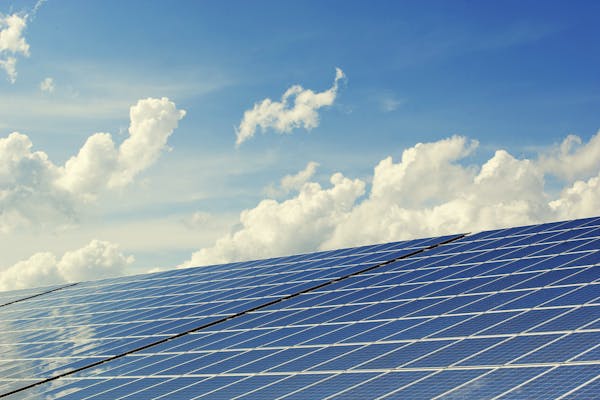The global demand for energy continues to grow at an unprecedented rate, driven by factors such as population growth, urbanization, and industrialization. Yet, the traditional energy sources that have powered humanity for centuries—fossil fuels like coal, oil, and natural gas—are finite and environmentally damaging. Their combustion releases significant amounts of carbon dioxide (CO2) and other greenhouse gases (GHGs), contributing to climate change. This predicament has led to the increasing prominence of Renewable Energy Technologies (RETs) as a viable alternative to mitigate environmental damage, address energy security concerns, and create a sustainable future.

Renewable Energy Technologies harness energy from natural sources such as sunlight, wind, water, and geothermal heat, which are naturally replenished. This article delves into the various types of renewable energy technologies, their advantages, challenges, and their pivotal role in the global transition to a greener, more sustainable energy future.
Solar Energy Technologies

Solar energy is one of the most abundant and promising sources of renewable energy on Earth. Solar technologies convert sunlight directly into electricity through photovoltaic (PV) cells or use solar thermal energy to generate electricity indirectly.
- Photovoltaic (PV) Systems PV systems, commonly referred to as solar panels, capture sunlight and convert it into direct current (DC) electricity through the photovoltaic effect. This occurs when photons from sunlight strike the semiconductor material in the cells, typically made of silicon, and release electrons, generating an electric current. PV systems can be installed on rooftops, ground-mounted, or integrated into building materials like windows or facades.
- Concentrated Solar Power (CSP) CSP technologies, unlike PV systems, use mirrors or lenses to concentrate sunlight onto a small area, typically heating a fluid. This heated fluid produces steam, which drives a turbine connected to an electric generator. CSP is often used for large-scale electricity generation and can incorporate thermal storage systems, allowing power generation even when the sun is not shining.
- Benefits and Challenges The primary benefit of solar energy is its abundance—every hour, the Earth receives more energy from the sun than humanity uses in an entire year. Solar energy technologies are also clean, producing no direct GHG emissions during operation. Moreover, the cost of solar PV systems has decreased dramatically in recent years, making them more competitive with traditional energy sources. However, solar energy faces challenges. The intermittent nature of sunlight, which depends on weather and the time of day, requires effective energy storage solutions or backup systems to ensure a consistent power supply. Additionally, large-scale solar farms require significant land area, potentially leading to land-use conflicts.
Wind Energy Technologies

Wind energy, another widely used renewable energy technology, converts the kinetic energy of moving air into electricity. Wind turbines, which can be installed on land (onshore) or offshore in bodies of water, capture wind energy through the rotation of blades attached to a generator.
- Onshore Wind Onshore wind turbines are typically installed in areas with consistent, strong winds, such as open plains, coastal regions, and hilltops. These turbines are relatively easy to install and maintain, and onshore wind energy is one of the cheapest forms of renewable energy today.
- Offshore Wind Offshore wind farms are installed in bodies of water, usually at some distance from the coast. Offshore wind offers several advantages, including stronger and more consistent winds, less visual and noise pollution, and the ability to install larger turbines. However, the installation and maintenance costs of offshore wind farms are higher due to the complexity of working in marine environments.
- Benefits and Challenges Wind energy technologies have the advantage of being scalable, with wind farms ranging from small, single-turbine installations to vast arrays of turbines generating gigawatts of power. Wind energy is clean and renewable, producing no direct emissions and having a small land footprint relative to its power output. However, wind energy faces similar intermittency issues as solar power—wind doesn’t blow consistently, and its strength can vary. This intermittency necessitates complementary energy storage solutions or integration with other energy sources to maintain a stable power supply. Additionally, wind farms can be subject to public opposition due to concerns about noise, aesthetics, and impacts on wildlife, particularly birds and bats.
Hydropower Technologies

Hydropower is the most established form of renewable energy and has been used for centuries to power machinery and generate electricity. It works by capturing the energy of flowing or falling water and converting it into mechanical energy, which drives a generator to produce electricity.
- Conventional Hydropower Involves constructing dams on rivers to create reservoirs, where water is stored and released to drive turbines. This method allows for controlled electricity generation and can provide a consistent, reliable power supply. Large-scale hydropower plants, such as the Three Gorges Dam in China, can generate vast amounts of electricity.
- Run-of-River Hydropower It does not rely on large reservoirs but instead use the natural flow of rivers. While they generate less power and are more susceptible to seasonal variations in water flow, run-of-river systems have a smaller environmental footprint and avoid the social and environmental impacts associated with large dam construction.
- Pumped Storage Hydropower It acts as a form of energy storage. During periods of low electricity demand, excess power is used to pump water from a lower reservoir to a higher one. When demand is high, the stored water is released to generate electricity, effectively acting as a battery for the electrical grid.
- Benefits and Challenges Hydropower offers several advantages, including reliability, the ability to provide baseload power, and a long operational lifespan. It also produces no direct emissions during operation. However, large-scale hydropower projects can have significant environmental and social impacts, such as habitat destruction, altered water flows, and displacement of local communities. Additionally, hydropower is vulnerable to changing climate patterns, particularly droughts, which can reduce water availability for power generation.
Geothermal Energy Technologies
Geothermal energy is a form of renewable energy that taps into the Earth’s internal heat to generate electricity or provide direct heating. This heat comes from the natural radioactive decay of elements in the Earth’s core, as well as residual heat from the planet’s formation.
- Geothermal Power Plants Geothermal power plants typically use steam or hot water from underground reservoirs to drive turbines connected to electricity generators. These plants are often located in geologically active regions, such as along tectonic plate boundaries or near volcanic areas, where heat is more readily accessible.
- Direct Use of Geothermal Energy Geothermal energy can also be used directly for heating purposes, such as in district heating systems, industrial processes, or agricultural applications. In these cases, geothermal heat is used without being converted into electricity, making it a highly efficient and cost-effective energy source for heating.
- Enhanced Geothermal Systems (EGS) Enhanced Geothermal Systems (EGS) involve drilling deep into the Earth’s crust and injecting water into hot rock formations to create a reservoir of steam or hot water that can be used to generate electricity. EGS has the potential to significantly expand the use of geothermal energy, even in regions without natural geothermal reservoirs.
- Benefits and Challenges Geothermal energy is a reliable and continuous source of renewable energy, providing baseload power with minimal environmental impact. It has a small land footprint and produces very low emissions, making it one of the cleanest energy technologies. However, geothermal energy is geographically limited to regions with accessible heat sources, and drilling deep into the Earth’s crust can be expensive and technically challenging.
Biomass Energy Technologies
Biomass energy is derived from organic materials, such as plant matter, agricultural residues, and animal waste, that can be converted into electricity, heat, or biofuels. Biomass technologies offer a versatile and renewable source of energy that can be used in a variety of applications.
- Biomass Power Plants It burn organic materials, such as wood chips, agricultural residues, or specially grown energy crops, to produce steam that drives turbines and generates electricity. These plants can operate continuously, providing a stable source of power.
- Biofuels such as ethanol and biodiesel, are liquid fuels derived from biomass materials. Ethanol, commonly made from corn or sugarcane, is blended with gasoline to reduce emissions, while biodiesel is used in diesel engines. Advanced biofuels, such as cellulosic ethanol and algae-based fuels, are being developed to offer more sustainable alternatives to conventional biofuels.
- Biogas It is produced through the anaerobic digestion of organic materials, such as food waste, manure, and sewage. This process generates methane-rich gas, which can be used for electricity generation, heating, or as a renewable natural gas for transportation.
- Benefits and Challenges Biomass energy is a versatile and renewable resource that can be used for electricity, heat, and transportation fuels. It also offers the potential for carbon-neutral energy production, as the CO2 released during combustion is offset by the CO2 absorbed during the growth of the biomass. However, the sustainability of biomass energy depends on responsible sourcing and land use practices. Large-scale biomass production can compete with food production, contribute to deforestation, and lead to other environmental issues if not managed carefully.
Energy Storage Technologies
As renewable energy technologies like solar and wind become more prevalent, energy storage systems are essential for addressing their intermittency. Energy storage allows excess energy generated during periods of high production to be stored and used when production is low, ensuring a consistent power supply.
- Battery Storage Lithium-ion batteries are the most widely used form of energy storage for renewable energy systems. They offer high energy density, fast response times, and scalability for both small and large applications. Other types of batteries, such as flow batteries and solid-state batteries, are being developed to improve efficiency and reduce costs.
- Pumped Hydroelectric Storage As previously mentioned, pumped hydroelectric storage is a well-established technology that uses excess electricity to pump water to a higher reservoir, which can then be released to generate electricity when needed.
- Thermal Storage Thermal storage systems store energy in the form of heat, which can be used for power generation or direct heating. Molten salt systems, for example, are used in CSP plants to store thermal energy for use when the sun is not shining.
- Benefits and Challenges Energy storage technologies are crucial for enabling the widespread integration of renewable energy into the grid. They help balance supply and demand, reduce the need for fossil fuel-based backup power, and enhance grid stability. However, the cost and scalability of energy storage systems remain significant challenges. Batteries, in particular, are expensive and have limited lifespans, though ongoing research and development are leading to improvements in performance and affordability.
The Future of Renewable Energy Technologies
The future of renewable energy technologies is bright, with continuous advancements in efficiency, cost reductions, and the development of innovative solutions to address the challenges of intermittency and scalability. As countries around the world commit to reducing their carbon emissions and transitioning to cleaner energy sources, renewable energy technologies will play an increasingly central role in the global energy landscape.
- Innovation and Research Ongoing research into next-generation renewable energy technologies, such as advanced solar cells, offshore wind innovations, and new forms of energy storage, is driving the industry forward. Emerging technologies, such as hydrogen fuel cells and carbon capture, utilization, and storage (CCUS), offer the potential to complement renewable energy and create a more diverse and resilient energy system.
- Policy and Market Drivers Government policies, such as renewable energy mandates, carbon pricing, and incentives for clean energy investment, are critical to accelerating the adoption of renewable energy technologies. At the same time, market forces, including the declining cost of renewable energy and growing consumer demand for sustainable products and services, are reshaping the energy sector.
- The Role of International Cooperation Global cooperation is essential for scaling renewable energy technologies and addressing the climate crisis. International organizations, such as the International Renewable Energy Agency (IRENA) and the United Nations Framework Convention on Climate Change (UNFCCC), play a crucial role in fostering collaboration and sharing best practices among nations.
Renewable Energy Technologies are revolutionizing the way we produce and consume energy. By harnessing the power of the sun, wind, water, and the Earth’s internal heat, these technologies offer clean, sustainable, and reliable energy solutions that can replace fossil fuels and reduce greenhouse gas emissions. While challenges remain, such as intermittency, cost, and infrastructure development, the future of renewable energy technologies is promising. As innovation continues and global commitments to sustainability grow, renewable energy will play an increasingly vital role in powering our planet for generations to come.





